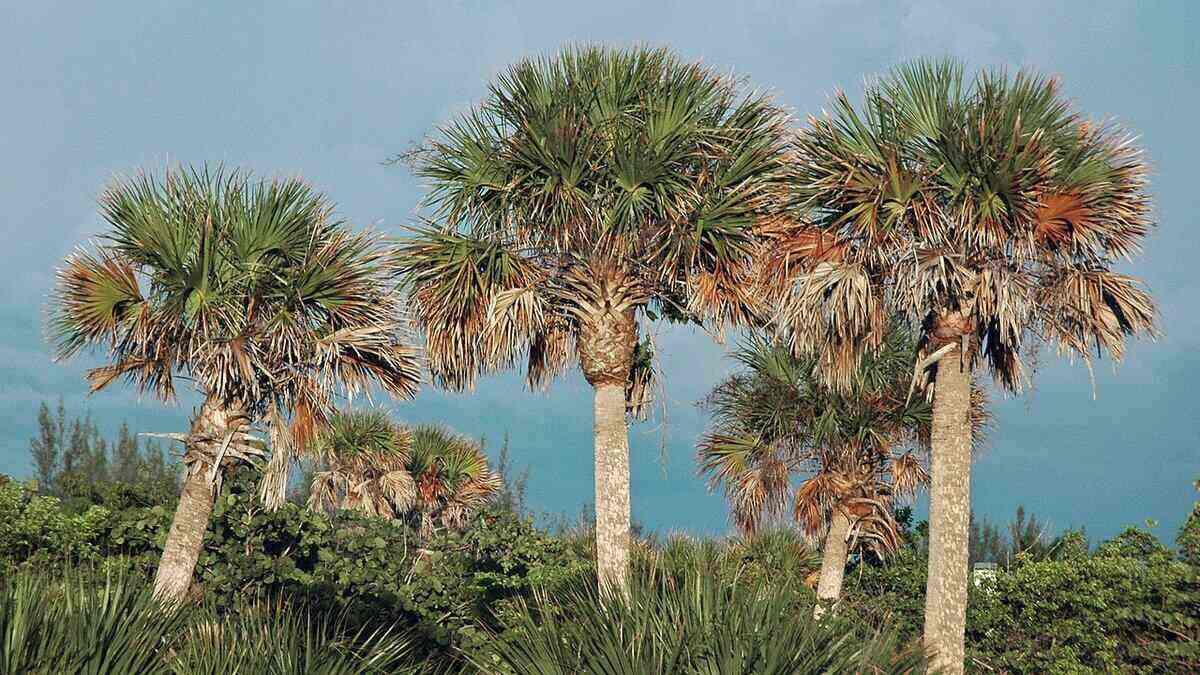
The very symbol of Florida – the palm tree – is under vicious attack by a disease that threatens to wipe out legions of trees. It’s estimated up to 10,000 have already fallen victim to this mysterious infection.
The disease is called lethal bronzing — formerly known as Texas Phoenix palm decline, until it spread out of the Lone Start State and started infecting more types of palm trees. So far, it’s infected 10 varieties of palms, including the sabal palm, Florida’s state tree.
Symptoms of Lethal Bronzing
- Lower fronds that die will have a bronze color.
- Flower spikes may die prematurely.
- New palms die and fold over.
- Fruits drop prematurely.
Dr. Brian Bahder, an expert in insect vector ecology at the University of Florida, thinks the infection arrived when Hurricane Wilma swept a species of insect up from the Yucatan. Another possibility? The insects were brought in from Texas after that state had an outbreak in 2002.
Central Florida has been especially hard hit.

“Orlando is on the northern edge of the area where it’s severe. It’s quite bad,” Dr. Bahder adds the disease has the potential to cause a massive die-off of Florida trees. He estimates the economic loss to nurseries has already reached into the millions of dollars.
Cause
Although scientists are not 100 percent certain, the leading suspect in the spread of the disease is a tiny insect called American palm cixiid (haplaxius crudus). The bug injects a lethal bacteria that strikes the tree’s vascular system, creating a deadly effect like the clogging of arteries in a human.
The adult insects are less than a quarter-inch in length and are straw-colored. They belong to a category of insects called treehoppers. In addition to “hopping” from tree to tree, Dr. Bahder says they are dispersed by wind and sometimes hitch rides on vehicles. “They prefer white or light-colored vehicles,” he said, and they may have hitchhiked north along I-95 to infect central Florida.
Once they infect a palm tree, nothing will save it. It has to be removed. “If a tree tests positive, it’s important to remove it as quickly as possible to remove the source of the pathogens,” Dr. Bahder said. “Otherwise, the disease could spread to nearby trees.”
If you’re a homeowner concerned about your palm trees, you have few options. “It’s quite tough. One of the challenges is that we don’t know how long the latent period is from infection until the symptoms show up,” Dr. Bahder said. Once the symptoms appear, it’s too late.
Prevention
Pesticides are not effective in controlling the disease. Preventive treatment is the best hope. Injection of special antibiotics seems to work as a preventive. Injections of oxytetracycline HCI every three to four months for two years can keep your tree from getting the fatal disease, according to a University of Florida publication.
TreeSaver, a leading vendor of the antibiotic, sells the product for $36 per bottle. Each bottle contains enough for 30 doses. You have to mix the powder with distilled water, drill a hole in the trunk, inject the solution, then sterilize the drill bit with a torch before moving on to the next tree. The process can be time-consuming and expensive, especially if you have several trees.
Many professional tree services offer the treatment for a fee.
Some scientists hope part of the solution may lie not in the trees, but in the grounds surrounding them. The suspected insect lays its eggs in grasses. They’ve been found in more than 70 varieties, including the Florida favorite St. Augustine grass. And they seem to prefer turf that is well-watered and fertilized. Given that homeowners tend to baby their lawns, they may unwittingly help spread the disease.

Research Ongoing
Dr. Bahder points out that research on the disease and a possible cure is still ongoing. In the meantime, “Prevention is the best solution,” he said. “If the disease is in your area, test your palms even if they look healthy. If something looks off on your palms, verify if the disease is affecting them. Be vigilant.”
Testing involves extracting DNA from the tree and is as tedious a project as injecting antibiotics. It involves drilling a sample from the trunk and sending it via overnight carrier to one of two laboratories. You’ll incur a $75 fee in addition to shipping charges.
Bahder says getting the disease under control is crucial. “It has the potential to drastically modify our landscape.”
Dr. Brian Bahder is an Assistant Professor of Entomology at the University of Florida. He specializes in insect vector ecology, and his research interests include the epidemiology of phytoplasmas infecting palms and other tropical ornamental plants.




